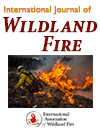International Journal of Wildland Fire
Volume 33
Number 10 2024
Fire creates stags by killing trees and also removes them. Proportions of stags lost usually exceed per capita mortality rates except after severe fire, when tree deaths greatly outnumber stag losses. Fire management is unlikely to increase the proportion of biomass in stags unless live biomass declines.
This article belongs to the Collection Savanna Burning.
Seedlings of Cape Proteaceae tend to occur in clumps and these clumps thin out with time to produce adult stands that are less clumped. We analysed seedling and adult densities and discuss the implications for trait evolution and dominance of reseeders over resprouters of strongly intra-specific clumping.
This paper introduces a 1D semi-physical model for WUI fires, integrating urban and wildland fire dynamics. It accounts for fire spread via direct flame contact, radiation and embers. Despite limited spatial and temporal variability, the model demonstrates the relative impact of structure properties and landscape layout on WUI fire spread.
We examined fire activity and phenology for major vegetation types across the UK for 2012–2023 and found that phenology rather than fire weather was the main driver for fire occurrence. Fire weather dominated only in years with extreme drought and heatwave events, which are likely to become more frequent with climate change.
We conducted interviews with three bushfire-affected populations in Australia to understand how they used bushfire maps during a bushfire event. Maps were commonly used amongst our sample; however, challenges surrounding the level of information they provided and comprehension of the maps indicate that bushfire map design can be improved.
NOAA’s Hazard Mapping System (HMS) smoke product, which comprises smoke plumes digitised from satellite imagery, was used as a proxy for surface smoke in recent air quality and public health assessments of fires. We find biases in HMS relative to airport observations, ground measurements and model estimates of surface smoke.
This article reviews traditional and contemporary methods that have been used to assess the accuracy of satellite active fire products and the consistency between products. We provide through this review generalised frameworks that advise on good practice for validating satellite fire products within the savannah biome.
This article belongs to the Collection Savanna Burning.





